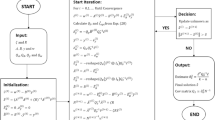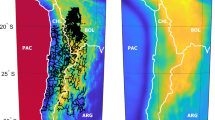Abstract
A new Kalman filter is presented in this work, enhanced with abilities and tools obtained from the area of Information Geometry (IG), for the optimization of the results of numerical weather prediction models. The new developments allow the better estimation of the discrepancies between modeled and corresponding observed data sets by categorizing them in the appropriate geometric framework and utilizing the associated geodesics/minimum-length-curves in order to estimate and minimize the necessary cost functions, instead of adopting least square based approximations. Numerical analysis techniques are developed and used for solving the associated boundary value problems. The proposed new IG Kalman filter is evaluated over idealized and real world test cases with very promising results. The systematic error of the simulations is almost eliminated and the forecast uncertainty is critically reduced.











Similar content being viewed by others
References
Amari S-I (1985) Differential geometrical methods in statistics. Springer, Berlin
Amari S-I, Nagaoka H (2000) Methods of information geometry. American Mathematical Society, Oxford University Press, Oxford
Arwini K, Dodson CTJ (2007) Alpha-geometry of the Weibull manifold. In: Second basic science conference, Tripoli
Arwini K, Dodson CTJ (2008) Information geometry: near randomness and near independence. Springer, Berlin
Astitha M, Kallos G, Mihalopoulos N (2005) Analysis of air quality observations with the aid of the source-receptor relationship approach. J Air Waste Manag Assoc 55:523–535
Balis D, Amiridis V, Kazadzis S, Papayannis A, Tsaknakis G, Tzortzakis S, Kalivitis N (2006) Optical characteristics of desert dust over the East Mediterranean during summer: a case study. Ann Geophys 24:807–821
Correia P, Lozano S, Chavez R, Loureiro Y, Cantero E, Benito P, Sanz Rodrigo J (2013) Wind characterization at the Alaiz-Las Balsas experimental wind farm using high-resolution simulations with mesoscale models. Development of a “low cost” methodology that address promoters needs. In: EWEA-13 proceedings, Vienna
Crochet P (2004) Adaptive Kalman filtering of 2-metre temperature and 10-metre wind-speed forecasts in Iceland. Meteorol Appl 11:173–187
D’Agostino RB, Stephens MA (1986) Goodness-of-fit techniques. Marcel Dekker, New York
Dykes JD, Wang DW, Book JW (2009) An evaluation of a high-resolution operational wave forecasting system in the adriatic sea. J Mar Syst 78(SUPPL. 1):S255–S271
Eskridge RE, Ku JY, Rao ST, Porter PS, Zurbenko IG (1997) Separating different scales of motion in time series of meteorological variables. Bull Am Meteorol Soc 78(7):1473–1483
Famelis I (2014) Runge–Kutta solutions for an environmental parameter prediction boundary value problem. System 2(2):62–69
Famelis I, Tsitouras Ch (2015) Quadratic shooting solution for an environmental parameter prediction boundary value problem. Far East J Appl Math 91(2):81–98
Famelis I, Galanis G, Ehrhardt M, Triantafyllou D (2014) Classical and quasi-Newton methods for a meteorological parameters prediction boundary value problem. Appl Math Inf Sci 8(6):2683–2693
Galanis G, Anadranistakis M (2002) A one dimensional Kalman filter for the correction of near surface temperature forecasts. Meteorol Appl 9:437–441
Galanis G, Louka P, Katsafados P, Kallos G, Pytharoulis I (2006) Applications of Kalman filters based on non-linear functions to numerical weather predictions. Ann Geophys 24:2451–2460
Galanis G, Emmanouil G, Kallos G, Chu PC (2009) A new methodology for the extension of the impact in sea wave assimilation systems. Ocean Dyn 59(3):523–535
Galanis G, Chu PC, Kallos G (2011) Statistical post processes for the improvement of the results of numerical wave prediction models. A combination of Kolmogorov–Zurbenko and Kalman filters. J Op Oceanogr 4(1):23–31
Galanis G, Chu PC, Kallos G, Kuo Y-H, Dodson CTJ (2012) Wave height characteristics in the North Atlantic Ocean: a new approach based on statistical and geometrical techniques. Stoch Environ Res Risk Assess 26:83–103
Giebel G (2001) On the benefits of distributed generation of wind energy in Europe. Ph.D thesis from the Carl von Ossietzky Universität Oldenburg, Düsseldorf
Ide K, Courtier P, Ghil M, Lorenc AC (1997) Unified notation for data assimilation: operational, sequential and variational. J Meteorol Soc 75:181–189
Irigoyen U, Cantero E, Correia P, Frías L, Loureiro Y, Lozano S, Pascal E, Sanz Rodrigo J (2011) Navarre virtual wind series: physical mesoscale downscaling wind WAsP. Methodology and validation. In: EWEC-11 European wind energy conference, Brussels
Janjic ZI (1994) The step-mountain eta coordinate model: further developments of the convection, viscous sublayer, and turbulence closure schemes. Mon Weather Rev 122:927–945
Joensen A, Giebel G, Landberg L, Madsen H, Nielsen H (1999) Model output statistics applied to wind power prediction. In: Proceedings of the European wind energy conference, 1177–1180, Nice
Kallos G (1997) The regional weather forecasting system skiron. In: Proceedings, symposium on regional weather prediction on parallel computer environments, 15–17 Oct, Athens, p 9
Kallos G, Papadopoulos A, Katsafados P, Nickovic S (2005) Trans-Atlantic Saharan dust transport: model simulation and results. J Geophys Res. doi:10.1029/2005JD006207
Kalman RE (1960) A new approach to linear filtering and prediction problems. J Basic Eng 82:35–45
Kalman RE, Bucy RS (1961) New results in linear filtering and prediction problems. Trans ASME Ser D 83:95–108
Kalnay E (2002) Atmospheric modeling, data assimilation and predictability. Cambridge University Press, Cambridge, p 341
Kariniotakis G, Marti I et al (2004) What performance can be expected by short-term wind power prediction models depending on site characteristics? In: CD-proceedings of the European wind energy conference EWEC, London
Kariniotakis G, Pinson P (2003) Evaluation of the MORE-CARE wind power prediction platform. Performance of the fuzzy logic based models. In: CD-proceedings of the European wind energy conference, Madrid
Korres G, Lascaratos A, Hatziapostolou E, Katsafados P (2002) Towards an ocean forecasting system for the Aegean sea. Glob Atmos Ocean Syst 8(2–3):191–218
Landberg L (1994) Short-term predictions of local wind conditions. Ph.D thesis, Riso National Laboratory, Denmark
Louka P, Galanis G, Siebert N, Kariniotakis G, Katsafados P, Pytharoulis I, Kallos G (2008) Improvements in wind speed forecasts for wind power prediction purposes using Kalman filtering. J Wind Eng Ind Aerodyn 96:2348–2362
Makarynskyy O (2004) Improving wave predictions with artificial neural networks. Ocean Eng 31(5–6):709–724
Makarynskyy O (2005) Neural pattern recognition and prediction for wind wave data assimilation. Pac Oceanogr 3(2):76–85
Mass CF, Ovens D, Westrick K, Colle BA (2002) Does increasing horizontal resolution produce more skillful forecasts? Bull Am Meteorol Soc 83(3):407–430
Nickovic S, Kallos G, Papadopoulos A, Kakaliagou O (2001) A model for prediction of desert dust cycle in the atmosphere. J Geophys Res 106:18113–18129
Papadopoulos A, Katsafados P (2009) Verification of operational weather forecasts from the POSEIDON system across the Eastern Mediterranean. Nat Hazards Earth Syst Sci 9:1299–1306
Papadopoulos A, Katsafados P, Kallos G (2001) Regional weather forecasting for marine application. Glob Atmos Ocean Syst 8(2-3):219–237
Pelland S, Galanis G, Kallos G (2011) Solar and photovoltaic forecasting through post-processing of the global environmental multiscale numerical weather prediction model. Prog Photovolt Res Appl. doi:10.1002/pip.1180
Rao ST, Zurbenko IG, Neagu R, Porter PS, Ku JY, Henry RF (1997) Space and time scales in ambient ozone data. Bull Am Meteorol Soc 78(10):2153–2166
Resconi G (2009) Geometry of risk analysis (morphogenetic system). Stoch Environ Res Risk Assess 23:425–432
Silva AP, Moulin LS (2000) Confidence intervals for neural network based short-term load forecasting. IEEE Trans Power Syst 15(4):1191–1196
Spyrou C, Mitsakou C, Kallos G, Louka P, Vlastou G (2010) An improved limited area model for describing the dust cycle in the atmosphere. J Geophys Res 115(D17):1–19
Stathopoulos C, Kaperoni A, Galanis G, Kallos G (2013) Wind power prediction based on numerical and statistical Models. J Wind Eng Ind Aerodyn 112:25–38
Vanem E (2011) Long-term time-dependent stochastic modelling of extreme waves. Stoch Environ Res Risk Assess 25:185–209
Varinou M, Kallos G, Kotroni V, Lagouvardos K (2000) The influence of the lateral boundaries and background concentrations on limited area photochemical model simulations. Int J Environ Pollut 14:354–363
Wilks D (1995) Statistical methods in the atmospheric sciences. Academic Press, Lake City
Zodiatis G, Lardner R, Georgiou G, Demirov E, Manzella G, Pinardi N (2003) An operational European global ocean observing system for the eastern Mediterranean Levantine basin: the Cyprus coastal ocean forecasting and observing system. Mar Technol Soc J 37(3):115–123
Zodiatis G, Lardner R, Hayes D, Georgiou G, Sofianos S, Skliris N, Lascaratos A (2008) Operational ocean forecasting in the Eastern Mediterranean: implementation and evaluation. Ocean Sci 4(1):31–47
Acknowledgements
This research has been co-funded by the European Union (European Social Fund) and Greek national resources under the framework of the “Archimedes III: Funding of Research Groups in TEI of Athens” project of the “Education & Lifelong Learning” Operational Programme. Moreover, the authors would like to thank the Atmospheric Modeling and Weather Forecasting Group of the Physics Department of the University of Athens (www.mg.uoa.gr) for providing environmental data valuable for the proposed analysis as well as further material and scientific support.
Author information
Authors and Affiliations
Corresponding author
Rights and permissions
About this article
Cite this article
Galanis, G., Famelis, I. & Liakatas, A. A new Kalman filter based on Information Geometry techniques for optimizing numerical environmental simulations. Stoch Environ Res Risk Assess 31, 1423–1435 (2017). https://doi.org/10.1007/s00477-016-1332-5
Published:
Issue Date:
DOI: https://doi.org/10.1007/s00477-016-1332-5




